OldSpeak
The Kennedy Assassination: CIA Conspiracy or a Lone Assassin? An Interview with Joan Mellen
By John W. Whitehead
March 08, 2006
“I guess part of me still thought I was living in the country I was born in.”—Jim Garrison
In A Farewell to Justice, Joan Mellen presents a comprehensive account of the investigative work of New Orleans District Attorney Jim Garrison into the assassination of President John F. Kennedy. This groundbreaking work offers extensive evidence that the cover-up began in Louisiana months before the President was shot.
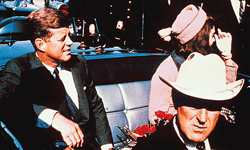 Garrison’s investigation points particularly to Clay Shaw, a decorated major in the U.S. Army and prominent New Orleans businessman who helped start the city’s International Trade Market, as a conspirator thought to have been implicated further in the assassination. Believing the true conspirators to be members of the political right wing, CIA personnel and anti-Castro Cuban exiles, Garrison was the only government official to indict a suspect for Kennedy’s murder, claiming to “have evidence beyond a shadow of a doubt.” Garrison identified Shaw as the mysterious “Clay Bertrand” in the Warren Report and had dozens of witnesses linking Shaw to Lee Harvey Oswald and CIA employee David Ferrie. In 1967, however, a jury ignored much of his important data, acquitting Shaw in less than an hour. A Farewell to Justice brings to light the contradictions found by Garrison in the Warren Report and reveals the high level of government sabotage in the assassination, denouncing claims that Oswald was an unstable pro-Castro Marxist who acted alone in killing President Kennedy and finding that instead he worked alongside the FBI, the CIA and even U.S. Customs.
Garrison’s investigation points particularly to Clay Shaw, a decorated major in the U.S. Army and prominent New Orleans businessman who helped start the city’s International Trade Market, as a conspirator thought to have been implicated further in the assassination. Believing the true conspirators to be members of the political right wing, CIA personnel and anti-Castro Cuban exiles, Garrison was the only government official to indict a suspect for Kennedy’s murder, claiming to “have evidence beyond a shadow of a doubt.” Garrison identified Shaw as the mysterious “Clay Bertrand” in the Warren Report and had dozens of witnesses linking Shaw to Lee Harvey Oswald and CIA employee David Ferrie. In 1967, however, a jury ignored much of his important data, acquitting Shaw in less than an hour. A Farewell to Justice brings to light the contradictions found by Garrison in the Warren Report and reveals the high level of government sabotage in the assassination, denouncing claims that Oswald was an unstable pro-Castro Marxist who acted alone in killing President Kennedy and finding that instead he worked alongside the FBI, the CIA and even U.S. Customs.
Though having a central focus on Garrison’s work, Mellen also undertook her own investigations, seeking to show a clear connection to the government and its intelligence agencies in both the involvement and cover-up of the Kennedy assassination. New evidence includes government documents revealing that the FBI and the CIA actively worked with journalists and reporters from Newsweek and The Saturday Evening Post and even a government operative at NBC television to “cover” the Garrison investigation. Mellen also reveals new information on Lee Harvey Oswald’s relationship to the International Trade Mart and CIA-sponsored anti-Castro figures in New Orleans.
A professor of English and creative writing at Temple University in Philadelphia, Mellen has authored seventeen books on various subjects, including biography, film criticism, fiction, sports, Latin American studies and true crime. Her articles have appeared in The New York Times, The Los Angeles Times, The Philadephia Inquirer and The Baltimore Sun. Her work The Battle of Algiers (1972) has been extensively quoted concerning its connection with the events of 9/11. Additional articles by Mellen can be found at www.joanmellen.net.
In this OldSpeak interview with John Whitehead, Joan Mellen elaborates on her research into the assassination of John F. Kennedy and challenges readers to reject complacency and engage in the daily struggle to speak truth to power.
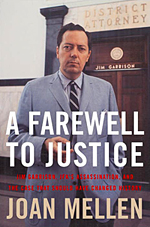
John Whitehead: It seems that as you researched this book, you became fascinated with the assassination. After eight years of research, in which you conducted 1,200 interviews, you concluded that Jim Garrison, the New Orleans district attorney, had it right in that the CIA—with the help of other U.S. government agencies—orchestrated the assassination of President John F. Kennedy and worked to thwart Garrison’s investigation. As with anyone who writes on the JFK assassination, there are those who completely dispel any kind of connection with the CIA and refute any kind of conspiracy. One review of your book by Mel Ayton, who has written several books on the JFK assassination, raises some questions. First, Ayton states: “Mellen’s theories, which center around a CIA conspiracy, make little sense once examined closely. Her allegations that Clay Shaw was created and supervised by the CIA have been examined time and time again by JFK researchers and found to be false.” Your response?
Joan Mellen: That is a complete falsehood. The files that were released by the CIA on Clay Shaw reveal that contrary to what his defenders alleged, Shaw was definitely a CIA operative. Shaw was not merely a businessman who was debriefed by the CIA after his trips to Latin America, the way hundreds of thousands of businessmen are debriefed. One of the interesting things I found in looking at these defenses of Clay Shaw is that the same language is used. Every single person defending Shaw uses either the word “routine” or “routinely.” An example of this is found in the movie Z, a film about the assassination of a Greek political figure named Gregory Lambrakis that occurred some six months before the Kennedy assassination. As a result of the investigation into the murder of Lambrakis, the way the Colonels were found to have been behind it was that they all used the exact same language when they were interviewed separately by the police. I think one of the phrases was “lies as a tiger.” Thus, by all of them using the same pat answer, it was clear that they were part of a conspiracy involved in the coup in Greece. When I look at the defense of Clay Shaw, I find the exact same situation. These people are mouthing the same words in their defense of him.
| “Clay Shaw owes his whole career to the CIA. The CIA then asks Shaw to do a favor and handle Lee Harvey Oswald in the state of Louisiana. And Shaw is not about to say no to this.” |
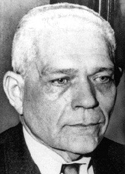 |
JW: Why do you think they are mouthing the same defense?
JM: Primo Levi, who was in the concentration camps in Germany during World War II, couldn’t understand the Nazi rationale for the camps. He went up to one of the guards and said, “Why are you doing this? It’s so inhumane. It’s beyond what humanity can understand.” The guard looked at Levi and said, “Here there is no wine.” In this instance, we are talking about the murder of the Head of State, the murder of the President of the United States in the streets of Dallas, Texas, by what appears overwhelmingly to have been a conspiracy on the part of the clandestine services of the CIA. Do you have to ask the question “why”?
JW: “Why” is always a good question.
JM: What I’m saying is that there is no rationale for the people who are willing to participate in such an act except that “there is no wine.” Let’s get back to my point about Clay Shaw and whether or not he was a businessman routinely debriefed by the CIA. When we look at the files, Shaw’s operation records would show overwhelmingly that he was on assignment for the CIA. And that far from being debriefed, Shaw was told what to do and what to tell them and what to look for. Then he fulfilled his assignment. Furthermore, CIA records show that Shaw’s files reside in the Operation’s Divison of the CIA, not in what was then called the Domestic Contact Service. If he were merely a businessman being debriefed, Shaw’s files would be in the Domestic Service and not in Operations. He was part of an operation, and that operation was a favor that Shaw was doing for the CIA in Louisiana. Why did Clay Shaw do them this favor? He owed everything, his life, to the CIA. Why would Shaw be made the managing director of the International Trade Mart in New Orleans? This is a CIA operation. And here is a man who was a high school dropout who never had a course in economics in his life. Shaw returns to New Orleans after serving in World War II and shortly thereafter is catapulted into the role of managing director of a huge organization called the International Trade Mart. Clay Shaw owes his whole career to the CIA. The CIA then asks Shaw to do a favor and handle Lee Harvey Oswald in the state of Louisiana. And Shaw is not about to say no to this.
JW: You say in your book that Garrison did have it right about Clay Shaw’s involvement with the CIA.
JM: That’s correct. There’s no question. Take a look at the records released under the Assassinations Review Act of 1992, which was passed by Congress. There are some four million documents available. Among them is enormous evidence that Clay Shaw was working for the CIA. Not only that, but in New Orleans after a certain point, the clandestine service and the Domestic Contact service merge. And the CIA’s field office in New Orleans handled both.
JW: Mel Ayton writes: “In November 1997 the Assassination Records Review Board, instituted by Congress as a result of public pressure after the release of the movie JFK, released Clay Shaw’s secret diary. In it he wrote of being wrongly persecuted, ‘I am still dismayed to find myself charged with the most heinous crime of the century but I am completely innocent and the feeling of being a stunned animal seems to have gone now.’ In another section of Shaw’s diary he wrote about his feelings of being accused of having associated with Lee Harvey Oswald and David Ferrie, ‘Aside from any questions of guilt or innocence,’ wrote Shaw, ‘anyone who knows me knows that I would have better sense than to plot with two nuts like that.’”
JM: This was a false diary. He wrote it after the fact, and he wrote it for the record. So naturally it was self-serving. The point is that Clay Shaw worked for the CIA and was involved in framing Lee Harvey Oswald. One of the achievements of Jim Garrison was to clearly identify who Lee Harvey Oswald really was. Oswald was not what he seemed. He certainly was not what the Warren Report said he was, which was this lone assassin with no confederates.
JW: Jim Garrison’s investigation into the assassination of JFK revealed many things. One of the key elements was the skepticism that Lee Harvey Oswald, with a bolt-action rifle, its telescopic sight loose and a tree obstructing his vision, could have acted on his own in shooting Kennedy. The conclusion was that it was a conspiracy and Oswald was “in on it.”
JM: This is true, but look who they had making the public believe it—J. Edgar Hoover. They had the whole FBI. They had the Warren Commission, which was really controlled by Allen Dulles, director of the CIA—the same man later fired by John F. Kennedy. Suddenly Lyndon Johnson, now as the President, appoints Dulles to run the Warren Commission. Obviously, they had a preordained conclusion. Also, bear in mind that three people on the Warren Commission dissented as to the conclusions of the panel. And Earl Warren wasn’t even allowed to print that three people on the Warren Commission dissented and refused to endorse the view that Lee Harvey Oswald had acted alone. These were Senator John Sherman Cooper, Representative Hale Boggs and Senator Richard Russell. These Congressmen wanted the Warren Commission Report to contain a dissent, and Earl Warren refused. So we can see that this Warren Commission is heavily controlled and has a preordained conclusion.
| “Oswald never thought he was going to kill President Kennedy. He thought he was involved in part of a CIA and Mafia plan to kill Fidel Castro.” |
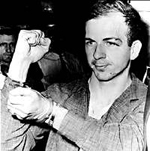 |
JW: Your book reveals quite a lot of information on Oswald.
JM: Yes. One of Garrison’s great breakthroughs was to discover Oswald taking a trip north of Baton Rouge to the cities of Clinton and Jackson in the company of Clay Shaw and the CIA contract pilot who was Garrison’s first suspect. This pilot was David Ferrie, who was played in the Oliver Stone film JFK by the actor Joe Pesci. Oswald’s assignment was to get a job at East Louisiana State Hospital at Jackson, but he didn’t even know that it was a mental hospital. Oswald went to the hospital’s barber shop, run by a man named Lee McGee, and said, “Does this hospital have many jobs?” And the barber said, “Well, you know, this is a mental hospital.” And Oswald said “Oh” because he didn’t know. Garrison was trying to understand why Clay Shaw would take Lee Harvey Oswald up to Jackson to get a job in the insane asylum. Remember that the conclusion of the Warren Commission Report was that Oswald was crazy, unstable and a sociopath. Garrison concludes that the idea was for Oswald to get a job at the mental hospital, behave erratically and suddenly he is a patient rather than an employee. Oswald escapes and appears at Dealey Plaza in Dallas as the insane gunman who kills President Kennedy. Oswald, however, never got the job at the hospital. The reason he didn’t get the job was because while he was there Oswald started behaving erratically and ranting and raving about how he was going to Cuba to kill Fidel Castro. Oswald never thought he was going to kill President Kennedy. He thought he was involved in part of a CIA and Mafia plan to kill Fidel Castro. At the hospital, Oswald was saying he was in the Marines and was going to kill Fidel Castro. The medical director, Dr. Frank Silva, a Cuban who came to the United States before Castro took power, just happened to be walking by while Oswald was ranting and raving. Dr. Silva took one look at him and said he would make sure that Oswald never got a job in the hospital. And so the CIA’s plan went awry. Oswald does not get the job but, of course, there are other ways of framing him.
| “Garrison had put Ferrie in a hotel, and Ferrie had admitted that he had been involved with the CIA. He said Clay Shaw was also with the CIA and that they were both CIA operatives. Then he died shortly thereafter.” |
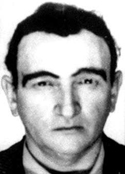 |
JW: Two of Oswald’s alleged co-conspirators, Guy Bannister and David Ferrie, both of New Orleans, died under suspicious circumstances after they were implicated in Garrison’s investigation. Do you believe the CIA was implicated in the suspicious nature of the deaths of these men?
JM: John, I don’t speculate and I don’t theorize in my book. Concerning Guy Bannister, Lee Harvey Oswald had an “office” on the second floor of Bannister’s detective agency. On one set of anti-Castro leaflets that Oswald passed out in New Orleans, he wrote the side-door address of Bannister’s office. Guy Bannister died in June of 1964. He could have been interviewed by the Warren Commission, but the Commission never talked to him. This is true even in light of the fact that Bannister knew Oswald well. And although Bannister’s death was ruled a heart attack, the Coroner at the time ruled all suspicious incidents as heart attacks of natural causes. But there is a story in my book about Guy Bannister’s wife telephoning a friend and saying that Guy had been shot. And I found other witnesses who corroborated the story that Guy had been shot. However, I should also add that when one of Garrison’s chief investigators went to look at Bannister’s body at the morgue, he didn’t see any effects of gun shots or anything unusual. So it’s unclear. Certainly it is at a very unusual moment during the period of the Warren Commission.
When David Ferrie died, he left typed suicide notes. But Jim Garrison didn’t conclude anything about Ferrie’s death. Garrison was about to arrest Ferrie, as his chief suspect, when Ferrie suddenly died. Garrison did not say for sure how Ferrie died, although my book discusses all the possibilities. The fact is that Ferrie had already begun talking. In fact, a few days before his death, Ferrie had telephoned Garrison’s chief investigator. Garrison had put Ferrie in a hotel, and Ferrie had admitted that he had been involved with the CIA. He said Clay Shaw was also with the CIA and that they were both CIA operatives. Then he died shortly thereafter. But this didn’t stop Garrison. He said, “Well, I am just getting started.” And a week later Garrison arrested Clay Shaw.
JW: A lot of people speculated as to the CIA’s involvement in the Kennedy assassination. For example, a month after Kennedy’s murder, former President Harry Truman expressed on the front page of the Washington Post his dismay that the CIA, which he had helped create, had been running a shadow government. Truman declared that the CIA was “in urgent need of correction.” Do you believe Truman was in part making reference to the JFK assassination?
JM: Excellent question. Coming one month after the assassination, it is pretty clear that what President Truman is signaling to the American public, but without saying so, is that perhaps even the CIA, which had been involved in so many assassinations and attempted assassinations that would only come out later publicly with the Church Committee hearing in the 1970s, this had been one of the CIA’s projects. Let me emphasize that Harry Truman does not say that. But coming with the timing that it did—the extraordinary act of a former president on the front page of a major newspaper, the Washington Post, talking about the CIA becoming operational—I think we can draw our own conclusions.
| “The CIA had been involved throughout the 1950s and during President Eisenhower’s administration with various attempted assassinations of foreign leaders and, of course, the endless attempts to murder Fidel Castro.” |
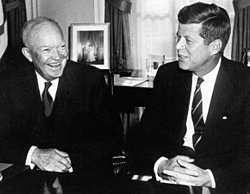 |
JW: When Dwight Eisenhower became president, he saw the autonomous nature of the CIA. As you write, “When Eisenhower in his much-quoted farewell address warned of the dangers of the military-industrial complex…he had in mind his own political sabotage at the hands of the CIA in the U-2 fiasco.” Eisenhower came to see that the CIA had evolved into an autonomous organization, and it greatly concerned him. Can you explain?
JM: President Eisenhower was a peace president. When Eisenhower defined national security, he said national security meant that the country was at peace and there was no deficit. This is in his farewell address. President Eisenhower also talks about the military- industrial complex, to which we should add the intelligence community as well. He was warning us against them, and he said that they are a threat to our civil liberties. And we see that today, of course, with the National Security Agency and the domestic electronic surveillance. We also see it with the USA Patriot Act and other laws where our civil liberties are being limited. President Eisenhower wanted to cap his presidency with a détente with the Soviet Union and a peace conference in Paris, a meeting of the big powers. But just at the last moment, a few weeks before this was scheduled, the CIA demanded to send one more U-2 to fly over the Soviet Union, and the famous downed U-2 fiasco occurred. President Eisenhower, however, cut off those U-2 flights.
JW: The pilot of that downed U-2 was Gary Powers.
JM: Powers was the pilot. I have a new document in my book that shows how a traitor from the United States, who was a national security operative turned spy, had given the Soviet Union information on how to down the U-2s without killing the pilots. So Francis Gary Powers lived. Of course, Powers did not kill himself, which he was supposed to do. There was a show trial in Moscow. As such, there was no way that the peace conference was going to come about in Eisenhower’s détente. This is another example of the CIA making policy. President Eisenhower wanted to create peace, and the CIA prevented it by staging this U-2 incident.
JW: By the early 1950s, the CIA had already become a rogue organization?
JM: The CIA had been involved throughout the 1950s and during President Eisenhower’s administration with various attempted assassinations of foreign leaders and, of course, the endless attempts to murder Fidel Castro. Moreover, as we now know, the Bay of Pigs operation was concocted not during President’s Kennedy’s administration but during President Eisenhower’s. The CIA was running its own show there. Thus, the CIA’s mischief has been going on a long time. I try to connect the Kennedy assassination with current events going on today. One of the failures of this country and its system of justice is the failure to bring before the bar of justice the people involved in the Kennedy assassination and to stop such activities. We can see some events today that are directly related to that. So I want to also stress that the Kennedy assassination is not a dead issue.
JW: We have seen ramifications from it today.
JM: Yes. It is an unfortunate fact that the people who attempted and carried out this and other assassinations were never brought to justice. But I want to note that the CIA under John F. Kennedy was not the same CIA that we have under George W. Bush. This truth is surfacing weekly. In fact, the CIA really told the truth about what was happening in Iraq. The CIA intelligence was good. The CIA knew that there were no weapons of mass destruction in Iraq. They told this to the current administration, which preferred to move forward rather than accept the good intelligence of the CIA. And as a result of the Bush Administration’s actions against the CIA, we see a decimation of the CIA’s clandestine services. The CIA was not to blame in this call up to war in Iraq. This is not the same institution that was involved in the murder of President Kennedy.
| “Kennedy was cutting the powers of the Director of Central Intelligence. Kennedy was, as Gerald Patrick Hemming, a CIA operative, said, “the last president to believe he could take power.” |
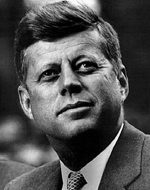 |
JW: As you note in your book, the CIA hated Kennedy most for his attempts to circumscribe their activities. In fact, Kennedy was quoted as saying that he was threatening to “splinter the CIA in a thousand pieces and scatter it to the wind.” Is that why the CIA thought he was going to do away with the agency? Is it why the decision was made to do away with President Kennedy?
JM: There are two motives for the CIA. One is this larger motive of the CIA opposing President Kennedy’s policies. And the other deals with the CIA representing what President Eisenhower called the military-industrial complex. The complex wanted war for monetary profit. We have to remember that the people who profited from the Vietnam War were Halliburton—Brown and Root became part of Halliburton in 1962, and Brown and Root profited from the Vietnam War, just as they would as Halliburton in Iraq. President Kennedy did not want a ground war in Vietnam. But Kennedy was not the Prince of Peace. Kennedy is the one who sent the Green Beret and Special Forces into Vietnam. Many thousands of people died as a result of that. But President Kennedy was not going to commit American troops and American boys to dying in the mud in Vietnam. He had issued the National Security Memorandum and was starting to bring the troops home. But as soon as President Kennedy is out of the way, a new policy develops. The CIA then helps the Halliburtons, Brown and Root, the Pentagon, the armament makers, the war machine and all those to profit enormously from the Vietnam War. This was the first motive.
But motive number two was the warfare that President Kennedy personally was involved in against the CIA. This is reflected in Kennedy’s quoted statement in the New York Times to “splinter the CIA into a thousand pieces and scatter them to the wind.” Kennedy had already begun to reduce CIA power. He wanted to take away the flights over Cuba and put them under other auspices. He was cutting the CIA budget. He was cutting the powers of the Director of Central Intelligence. Kennedy was, as Gerald Patrick Hemming, a CIA operative, said in one of his interviews with me, “the last president to believe he could take power.” So we see a vicious battle here.
JW: Since then, no president has really challenged the CIA.
JM: That’s right, and I think Hemming was correct. Kennedy was a very shrewd, intelligent man. He was the last president who thought he could take power. Recently, when Bush gave his State of the Union Address, he looked up at Cheney, who was standing behind him, for his approval. Cheney gave him the thumbs up. This President is not in control. He is not in power. I believe Hemming was right. President Nixon was terrified. President Johnson immediately sent troops to Vietnam. I don’t think Johnson particularly relished the idea of all those boys dying in Vietnam at all.
JW: Is the CIA still a secret state in this country? Does it still have an immense power to threaten the President?
JM: I don’t know exactly what the CIA is doing right now. I can only tell you that there is overwhelming evidence of an involvement of clandestine services of the CIA in the assassination of President John F. Kennedy.
JW: Then came the Bay of Pigs. After the Bay of Pigs, John Kennedy fired the head of the CIA, Allen Dulles. Where Eisenhower had exercised some constraint, Kennedy was, as you quote a former CIA asset as saying, “the last president to believe he could take power.” Only a month after the Bay of Pigs, Kennedy formed his own special group, meeting as the President’s Foreign Intelligence Advisory Board. Its express purpose was to bring the CIA under control.
JM: President Kennedy was terribly isolated in his own government. As Gerald Patrick Hemming said, Kennedy really didn’t realize how little power he had. And the CIA did everything it could to try to stifle President Kennedy’s administration. When the Soviet Union placed missiles in Cuba and the CIA had information about it, they leaked that information to Senator Kenneth Keating, rather than present it to the President of the United States. When Keating got up in the Senate and started giving information, Kennedy wondered how he had gotten it. President Kennedy at that point was quoted in Richard Reeves’ excellent biography as saying, “I am going to get those CIA bastards if it’s the last thing that I do.” We can really see here what President Charles De Gaulle called intra-government warfare between President Kennedy and the CIA.
Thus, you are quite right, John, to ask the question of motive. Why would the CIA do such a thing? We can see exactly why their very existence was threatened.
| “Some people believe that Bobby Kennedy thought that when he became President, he could make public what had happened to his brother. But that is just speculation. I believe that Bobby was implicated so deeply that he had to remain silent for the rest of his life.” |
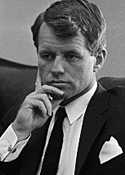 |
JW: Unknowingly, Bobby Kennedy, as you write, “was enlisting the CIA’s murder apparatus (‘executive action’ capability), the very apparatus soon to be turned against his brother. So Bobby Kennedy fell into a CIA trap that would render him silent about the murder of his brother for the rest of his life.”
JM: What many people don’t want to recognize is that just as the CIA and the Mafia were involved in assassination attempts on Fidel Castro, so was Bobby Kennedy. He had his own team. Bobby had General Edward Lansdale who, of course, was disloyal to him and was constantly reporting to J. Edgar Hoover. Bobby also had a group of Cubans, among whom was Angelo Murgado. Bobby, knowing the warfare that had been going on between the Kennedys and the CIA, was very worried that some hothead might kill President Kennedy. They were very frightened of that so Bobby sent his team of Cubans up to New Orleans. As Murgado said to me, they knew that “something was cooking in New Orleans.” And who should they find right in the middle of the anti-Castro community? Lee Harvey Oswald. Bobby became aware of Oswald three months before the assassination. Bobby’s people discover that Lee Harvey Oswald is working for the FBI as part of the FBI field office in New Orleans. Bobby Kennedy then makes the mistake of underestimating his enemies in the CIA. And he says to himself, as Angelo told me, “If Oswald is being controlled by the FBI, he’s no threat.” So they left him alone. One of the things Bobby wanted to do later was conceal the fact that he was involved in the plots to murder Fidel Castro and also that he was aware of Oswald—and that Oswald was even close to Bobby Kennedy’s own people who were involved in these assassination plots against Fidel Castro. If this information had surfaced, it would have ruined Bobby Kennedy’s political career. So he has to remain silent. Some people believe that Bobby Kennedy thought that when he became President, he could make public what had happened to his brother. But that is just speculation. I believe that Bobby was implicated so deeply that he had to remain silent for the rest of his life.
JW: If he had any integrity, which I think Bobby Kennedy did, eventually he may have done something to make some of the assassination information public.
JM: So he said. But just as he wins the primary in the state of California, Bobby is assassinated. So when it looks as if Bobby Kennedy is really going to become President, he cannot be allowed to live. I had the opportunity in 2003 to speak to Thomas Noguchi, who was the coroner of Los Angeles at the time of the assassination of Robert Kennedy. He did the autopsy. And to this day, his career is destroyed because he told the truth. Dr. Noguchi said Robert Kennedy was killed with a bullet to the back of the head which indicates, of course, that Sirhan Sirhan could not possibly have been the assassin of Robert Kennedy. That leads to a conspiracy. It is a subject that belongs to other people to investigate and write.
JW: As fate would have it, Abraham Zapruder was in Dallas on that November day in 1963 and filmed the assassination of the President. Doesn’t the Zapruder film show clearly that Kennedy was shot from the front and that he was shot more than once? Even Zapruder himself testified that JFK was shot from the front, instead of the back, as the Warren Commission reported. Do you think that if the American people had been able to see the Zapruder film shortly after the assassination, it would have changed things?
JM: It certainly would have. The first time the Zapruder film was shown publicly was at the trial State of Louisiana vs. Clay Shaw. The prosecutor showed it over and over again. Clay Shaw was stunned. The defense team for Shaw stood up and said, “Judge Haggerty, do we have to see this one more time?” The judge replied, “They can show it as many times as they want to.” It was overwhelming. Later, Garrison sent copies of the Zapruder film to universities throughout the country so the public could see it.
| “The Zapruder film overwhelmingly shows that President Kennedy was shot from the front and not from the back, as the Warren Commission concluded.” |
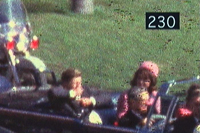 |
JW: What do you think the Zapruder film shows?
JM: The Zapruder film overwhelmingly shows that President Kennedy was shot from the front and not from the back, as the Warren Commission concluded. I conducted an interview with Dr. Robert McClelland, who was one of the doctors at Parkland Hospital trying to save President Kennedy’s life. Dr. McClelland held the head of the President and told me that the back of his head was completely blown away, which again indicates that the shot had to have come from the front. In the 1970s, Dr. McClelland went to the National Archives. He looked at the government photographs and x-rays and found that the back of the skull of President Kennedy had been reconstituted. They had created false photographs.
The Zapruder film is the wonderful acoustic evidence done by Don Thomas in Texas. Thomas’s work, which you can find on the Internet, shows overwhelmingly that there were at least four shots fired in Dealey Plaza. This indicates that there had to be a conspiracy because Oswald could not have fired four shots with the rifle. And, of course, it disproves the absurd magic bullet theory, which made the political career of Pennsylvania Senator Arlen Specter.
JW: In the 1960s, John Kennedy was killed, then Martin Luther King, followed by Robert Kennedy. There was an assassination matrix of three people who posed a threat to the Establishment. For example, Martin Luther King came out against the Vietnam War. Do you think it is possible that the CIA eliminated anyone who posed a real threat to the military-industrial complex?
JM: Jim Garrison, along with others, said that a coup d’etat occurred during that time. Power in the United States changed hands. Garrison said, “How did you think you could prosecute anybody for the murder of the President of the United States in a state court in Louisiana?” And then he would say, “I guess I thought I was living in the country I was born in.” After the Kennedy assassination, we had a coup d’etat. Power switched over to Halliburton-type corporations and the defense-contracting industry with the Pentagon, The President’s power is much reduced now. We have moved closer to what Martin Garbus called in the New York Observer a police state.
JW: The military-industrial complex has now basically taken control of the American government. True or false?
JM: I think that happened at the Kennedy assassination.
JW: We are at war in Iraq. There is a war in Afghanistan. We are probably getting ready to go to war with some other country. Is it the profit and/or power motive?
JM: Right. It’s also in order to do it. Democracy is a casualty. The hypocrisy of talking about bringing democracy to other countries while destroying it here has to be noted. Martin Garbus, who is a lawyer for the New York Times, wrote in the New York Observer that he saw similarities between what the United States is today and Weimar, Germany. And he said that we are in a very dangerous place. I don’t think the danger can be underestimated. As I said, it all goes back to the Kennedy assassination, which Richard Nixon used to talk about even in euphemism. When he wanted to talk about the Kennedy assassination, he called it the Bay of Pigs. The CIA Bay of Pigs operation and the coup d’etat with the Kennedy assassination have brought us directly to this situation we find ourselves in today.
JW: People such as yourself are shouting in the wilderness. Are there some things that are so big and so overwhelming that most people just cannot believe it?
JM: I think people don’t want to believe it. I think people don’t want to live in a country where the CIA killed the President. That is not a very comfortable place to be living in.
JW: Is that why they deny reality?
JM: I don’t believe people are stupid. I think it is unpleasant. It’s uncomfortable. And people like comfort. They like complacency. They like what is called the comfort zone. This is because if you knew that you were living in Weimar, Germany, you better do something about it. You would have to act. You would have to make personal sacrifices. People like Jim Garrison and others made tremendous personal sacrifices. I think most people do not want to do that. They want to live a pleasant personal life. So do I.
JW: What hope do you see for the future?
JM: I don’t know. We have to struggle day by day. We have to present the truth. If somebody tries to stop us, we have to call out our forces. We have to demonstrate. We have to speak the truth to power every opportunity we get. We have libraries. We have book stores. We have organizations like yours. We have this interview. We still have a chance to speak out and tell the truth. If we don’t do it now, I don’t know when we are going to do it.
DISCLAIMER: THE VIEWS AND OPINIONS EXPRESSED IN OLDSPEAK ARE NOT NECESSARILY THOSE OF THE RUTHERFORD INSTITUTE.


